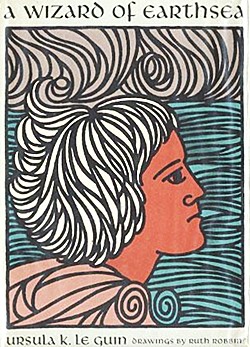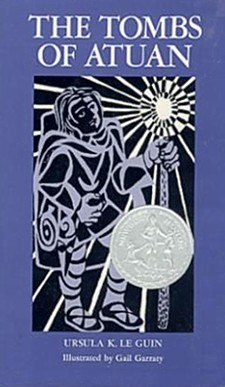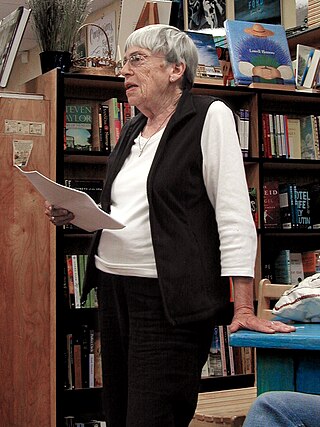
A Wizard of Earthsea is a fantasy novel written by American author Ursula K. Le Guin and first published by the small press Parnassus in 1968. It is regarded as a classic of children's literature and of fantasy, within which it is widely influential. The story is set in the fictional archipelago of Earthsea and centers on a young mage named Ged, born in a village on the island of Gont. He displays great power while still a boy and joins a school of wizardry, where his prickly nature drives him into conflict with a fellow student. During a magical duel, Ged's spell goes awry and releases a shadow creature that attacks him. The novel follows Ged's journey as he seeks to be free of the creature.

Ursula Kroeber Le Guin was an American author. She is best known for her works of speculative fiction, including science fiction works set in her Hainish universe, and the Earthsea fantasy series. Her work was first published in 1959, and her literary career spanned nearly sixty years, producing more than twenty novels and over a hundred short stories, in addition to poetry, literary criticism, translations, and children's books. Frequently described as an author of science fiction, Le Guin has also been called a "major voice in American Letters". Le Guin said she would prefer to be known as an "American novelist".

The Dispossessed is a 1974 anarchist utopian science fiction novel by American writer Ursula K. Le Guin, one of her seven Hainish Cycle novels. It is one of a small number of books to win all three Hugo, Locus and Nebula Awards for Best Novel. It achieved a degree of literary recognition unusual for science fiction due to its exploration of themes such as anarchism and revolutionary societies, capitalism, utopia, individualism, and collectivism.

The Tombs of Atuan is a fantasy novel by the American author Ursula K. Le Guin, first published in the Winter 1970 issue of Worlds of Fantasy, and published as a book by Atheneum Books in 1971. It is the second book in the Earthsea series after A Wizard of Earthsea (1969). The Tombs of Atuan was a Newbery Honor Book in 1972.

The Earthsea Cycle, also known as Earthsea, is a series of high fantasy books written by American author Ursula K. Le Guin. Beginning with A Wizard of Earthsea (1968), The Tombs of Atuan, (1970) and The Farthest Shore (1972), the series was continued in Tehanu (1990), and Tales from Earthsea and The Other Wind. In 2018, all the novels and short stories were published in a single volume, The Books of Earthsea: The Complete Illustrated Edition, with artwork by Charles Vess.

The Other Wind is a fantasy novel by the American author Ursula K. Le Guin, published by Harcourt in 2001. It is the fifth and final novel set in the fictional archipelago Earthsea. It won the annual World Fantasy Award for Best Novel and was runner up for the Locus Award, Best Fantasy Novel, among other nominations.

Orsinian Tales is a collection of eleven short stories by American writer Ursula K. Le Guin, most of them set in the imaginary Eastern European country of Orsinia.

Rocannon's World is a science fiction novel by American writer Ursula K. Le Guin, her literary debut. Published in 1966, it appeared as an Ace Double, with an opening entitled "Semley's Necklace" that first appeared as the stand-alone story, "The Dowry of Angyar", in Amazing Stories in September 1964. The novel is one of several of Le Guin's works taking place in the same universe and with relationships of characters and history, works that have been termed the Hainish Cycle. Its story presents many elements of heroic fantasy.

Malafrena is a 1979 novel by Ursula K. Le Guin. The only fantastic element of this novel is that it takes place in the imaginary Central European country of Orsinia, which is also the setting of her collection Orsinian Tales.
"The Word of Unbinding" is a short story by American writer Ursula K. Le Guin, first published in the January 1964 issue of Fantastic, and reprinted in collections such as The Wind's Twelve Quarters. In this story, the Earthsea realm, later made setting of the novel A Wizard of Earthsea, was first introduced. Along with the story "The Rule of Names", this story conveys Le Guin's initial concepts for the Earthsea realm, including its places and physical manifestation, but not the characters appearing in the novels.

The Wind's Twelve Quarters is a collection of short stories by American writer Ursula K. Le Guin, named after a line from A. E. Housman's A Shropshire Lad, and first published by Harper & Row in 1975. A retrospective of Le Guin's short stories, it collects 17 previously published pieces of speculative fiction. Four of these were the germs of novels she was to write later, and a few others shared connections to Le Guin novels. At least four stories are set in the Hainish Universe, and two others in Earthsea. Many stories share themes and motifs, including time and utopia: certain images and characters also recur, including isolated scholars or explorers seeking knowledge in a hostile world.
Annals of the Western Shore is a young adult fantasy series by Ursula K. Le Guin. It consists of three books: Gifts (2004), Voices (2006), and Powers (2007). Each book has different main characters and settings, but the books are linked by some recurring characters and locations. Gifts won the PEN Center USA 2005 Children's literature award. Powers won the 2008 Nebula Award for Best Novel.

"The Shobies' Story" is a 1990 science fiction novella by American writer Ursula K. Le Guin, describing the story of the first human crew to participate in a newly invented faster-than-light mode of space travel. It was first published in the anthology Universe 1 and subsequently appeared in A Fisherman of the Inland Sea published by Harper Prism in 1994.

Ursula K. Le Guin (1929–2018) was an American author of speculative fiction, realistic fiction, non-fiction, screenplays, librettos, essays, poetry, speeches, translations, literary critiques, chapbooks, and children's fiction. She was primarily known for her works of speculative fiction. These include works set in the fictional world of Earthsea, stories in the Hainish Cycle, and standalone novels and short stories. Though frequently referred to as an author of science fiction, critics have described her work as being difficult to classify.

Voices (2006) is the second book in the trilogy Annals of the Western Shore, a young adult fantasy series by Ursula K. Le Guin. It is preceded in the series by Gifts (2004) and followed by Powers (2007). The story is set in the fictional city of Ansul, once famed as a center of learning, but invaded and subjugated by the Alds, a desert people who believe the written word to be evil. The protagonist, Memer Galva, is the child of a woman raped by an Ald soldier. She lives in the house of the Waylord Sulter Galva, who teaches her to read after finding she can enter the house's hidden library. When Memer is seventeen the city is visited by Gry and Orrec, the protagonists of Gifts; Orrec is now a famous poet, invited to perform by the Alds. Their arrival catalyzes an uprising against the Alds, while Memer tries to come to terms with her ability to interpret the Oracle that resides in her house.

"Coming of Age in Karhide" is a science fiction short story by Ursula K. Le Guin, first published in 1995. The story is set on the fictional planet of Gethen, the same as Le Guin's 1969 novel The Left Hand of Darkness, and is a part of Le Guin's Hainish cycle. The story explores themes of growing into adulthood on a planet where individuals have no fixed gender identity. Reviewers stated that the story went further than Left Hand in its exploration of gender and sexuality, and was a "quietly feminist" work. It was also described as lacking the "dizzying impact" of Left Hand. In 2002, it was anthologized in the volume The Birthday of the World, along with many other stories exploring marriage and sexual relationships.
"Vaster than Empires and More Slow" is a science fiction story by American author Ursula K. Le Guin, first published in the collection New Dimensions 1, edited by Robert Silverberg. It is set in the fictional Hainish universe, where Earth is a member of an interstellar "League of Worlds". The anthology was released in United States in 1971, by Doubleday Books.
"The Dowry of Angyar" is a science fiction short story by American writer Ursula K. Le Guin, first published in 1964. It is the first work of the Hainish Cycle. The story is set on a fictional planet of the star Fomalhaut and follows a highborn woman as she tries to track down a family heirloom. It was framed by commentary from ethnologists studying the intelligent life forms of the Fomalhaut system. The story drew from Norse mythology, including the legend of the Brísingamen, and explored the concept of time dilation. "The Dowry of Angyar" drew comments for its stylistic devices, while a review praised Le Guin's writing as "crystalline prose". It was later used as the prologue to Le Guin's 1966 novel Rocannon's World. In later publications, including in the 1975 anthology The Wind's Twelve Quarters, the story was given the title "Semley's Necklace".

Paradises Lost is a science fiction novella by American author Ursula K. Le Guin. It was first published in 2002 as a part of the collection The Birthday of the World. It is set during a multigenerational voyage from Earth to a potentially habitable planet. The protagonists, Liu Hsing and Nova Luis, are members of the fifth generation born on the ship. The story follows them as they deal with members of a religious cult who do not believe in the ship stopping at its intended destination. They also face a crisis brought on by a drastic change in the ship's schedule. The novella has since been anthologized as well as adapted into an opera of the same name.

"Old Music and the Slave Women" is a science fiction story by Ursula K. Le Guin. It was first published in the 1999 collection Far Horizons, edited by Robert Silverberg, and anthologized multiple times in collections of Le Guin's works. The story is set on the planet of Werel in the fictional Hainish universe, created by Le Guin. That planetary system is also the setting for Le Guin's 1995 story suite Four Ways to Forgiveness. The economy of Werel is based on slavery, and during the period in which the stories are set, the society is experiencing upheaval and revolution.















